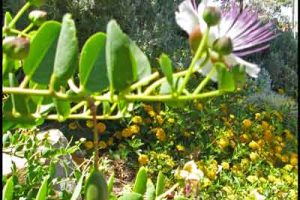Capparis spinosa
Capers, caper bush, Flinders rose
Origin
Capers are native to the Mediterranean, the Middle East, Western & Central Asia, China, the Indian sub-continent & Australia. Archaeological studies in Egypt, Syria & China indicate different plant parts were used as condiments & to treat a wide range of medical ailments thousands of yrs ago. Mediterranean countries account for most commercial production nowadays.
Climate
Mediterranean-type climate, semi-arid or arid where rainfall may be <300mm/yr. It is well adapted to harsh environments. They grow well in Perth, plus areas as far north as Geraldton and in the South West. Frost may affect the growth of young plants & with maturity they can tolerate temperatures above 40°C.
Plant Description
Capparis spinosa L. (caper) is the type species of the genus which exhibits diverse morphology. It is a small deciduous prostrate xerophilous perennial shrub growing to 50-80cm high with branches 1-3 m long. Roots can be several metres long with biomass greater than above-ground parts, enabling very efficient scavenging of soil water at depth; roots can also store water for use when needed. Densely-crowded alternate ovate–lanceolate simple leaves are 2-5cm long, leathery, glabrous or pubescent, green on top, silverish underneath, & sometimes have prominent veins. Stipules are commonly expressed as thorns, giving the species its name. Diploid chromosome number is 38.
Relatives
It is in the Capparaceae family which has 40-45 genera and 700-900 species. There are currently 143 accepted species in Capparis, with numerous sub-species & varieties. C nummularia is variously described as a spinosa variety or as a separate species; it is the taxon most commonly found in Australia. Inter-species & varietal crossing occurs frequently.
Soils
With good drainage, capers can be grown in a wide range of soils including those that are poor & infertile. Preference is for sandy & sandy loams with pH 7.5-8. The plant has relatively good salt tolerance.
Propagation
Seeds are the main means of propagation. Stored at low humidity & temperature they maintain their viability for a few years. Capers are usually found to be difficult to propagate & this is mainly due to the tough & relatively impermeable seed coat. However if they are scarified (mechanical or acid), then adequate imbibition can occur with epigeal germination in 25-30 days & success rates of 60% or more. Equivalent results can also be achieved using 15cm long soft wood cuttings after dipping in rooting hormone, preferably with use of bottom heat. Grafting is less commonly used.
Cultivars
Varieties have been selected for spinelessness, round firm buds, flavour, high yield, and coordinated flowering periods, but they are very difficult to source in Australia. Little breeding work has been done, meaning the species is still basically in the wild state.
Flowering and Pollination
Inflorescences are usually axillary, 2-10 flowered but most often single. Attractive & fragrant andromonoecious flowers about 7cm wide are mainly symmetrical & nocturnal, from 6pm to 10am the next morning. The calyx has 4 sepals & 4 attractive & white or white-pinkish rounded petals. There may be up to 200 stamens with long purplish filaments. The 3-6cm long superior ovary has 5-10 carpels & is supported on a substantial gynophore. Continuous flowering is from late October to May in Perth, with insects & especially bees being the main pollinators.
Cultivation
Transplanting should be done in wet weather & spaced 2-2.5m apart. First-year plants should be adequately mulched; mycorrhizal associations assist nutrient uptake in poor soils. They are slow to establish but can live for 20-30 years.
Hardiness allows commercial plants to be grown in non-irrigated areas.
Wind Tolerance
As a low spreading shrub, capers have good wind tolerance.
Pruning
Heavy branch pruning is crucial for good production as flower buds develop on one-year-old branches. Any dead wood or water sprouts should be removed during the winter months.
The Fruit
The small (1.5-5 X 1-2cm) obovoid berry has a thin smooth or ribbed pericarp & is usually dehiscent. It’s the immature green flower buds that are mainly used. If flower buds ae not picked green they will develop into flowers and eventually into the small mature fruits that have pale crimson flesh & up to 400 minute (150/g) reddish-brown seeds. Fruits are also edible and have a milder taste than the immature flower buds. Useful levels of antioxidants have been reported in the buds & other plant parts.
Fruit Production and Harvesting
Plants begin flowering & fruiting after about 4 years. Buds can be picked by hand every few days, with up to 3 kg/plant/ yr possible when fully mature.
Fruit Uses
Fresh caper fruit buds and berries have an intensely bitter taste, but pickling in white vinegar removes this. They are used as a garnish, in salads & salad dressings & as condiments; they have a sharp, piquant flavour due to release of mustard oil.
Unripe fruits and young twigs are sometimes also pickled, & caper berries are sometimes fermented in water for 4-7 days.
Pests and Diseases
None have been noticed in suburban Perth.
Comments
Capers grow well in home gardens here & one plant should be enough for a family’s needs. Plus, they are attractive and hardy, requiring very little water once established. Picking and pruning should be done regularly. Bushes can be planted on slopes to control erosion.
